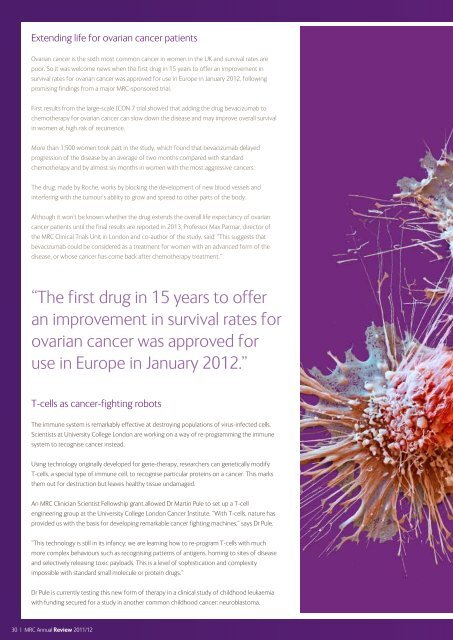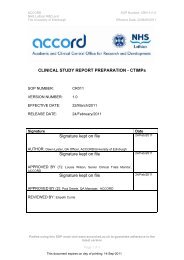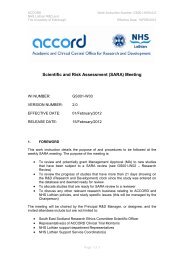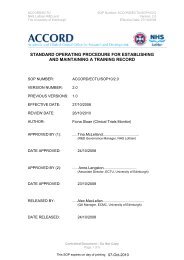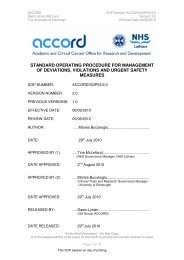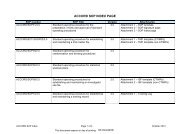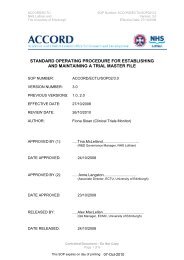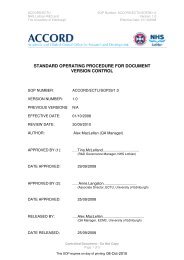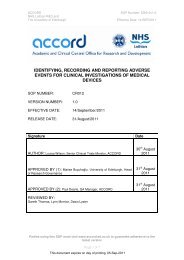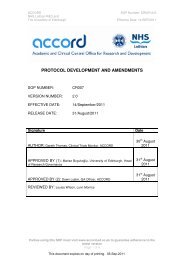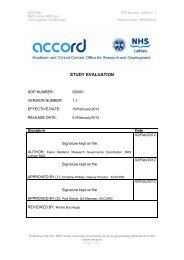Advancing medicine, changing lives - Medical Research Council
Advancing medicine, changing lives - Medical Research Council
Advancing medicine, changing lives - Medical Research Council
Create successful ePaper yourself
Turn your PDF publications into a flip-book with our unique Google optimized e-Paper software.
Extending life for ovarian cancer patients<br />
Ovarian cancer is the sixth most common cancer in women in the UK and survival rates are<br />
poor. So it was welcome news when the first drug in 15 years to offer an improvement in<br />
survival rates for ovarian cancer was approved for use in Europe in January 2012, following<br />
promising findings from a major MRC-sponsored trial.<br />
First results from the large-scale ICON 7 trial showed that adding the drug bevacizumab to<br />
chemotherapy for ovarian cancer can slow down the disease and may improve overall survival<br />
in women at high risk of recurrence.<br />
More than 1,500 women took part in the study, which found that bevacizumab delayed<br />
progression of the disease by an average of two months compared with standard<br />
chemotherapy and by almost six months in women with the most aggressive cancers.<br />
The drug, made by Roche, works by blocking the development of new blood vessels and<br />
interfering with the tumour’s ability to grow and spread to other parts of the body.<br />
Although it won’t be known whether the drug extends the overall life expectancy of ovarian<br />
cancer patients until the final results are reported in 2013, Professor Max Parmar, director of<br />
the MRC Clinical Trials Unit in London and co-author of the study, said: “This suggests that<br />
bevacizumab could be considered as a treatment for women with an advanced form of the<br />
disease, or whose cancer has come back after chemotherapy treatment.”<br />
Humble aspirin can protect against cancer<br />
Twenty years of dedicated research has confirmed that a daily dose of aspirin can reduce<br />
the long-term risk of developing cancer.<br />
The CAPP-2 trial, part-funded by the MRC, found that cancer risk can be cut by 60 per cent in<br />
people with a strong family history of the disease, but it takes at least five years for this effect<br />
to become apparent.<br />
Evidence that aspirin protects against cancer risk has been accumulating for decades, but this<br />
was the first study to examine the suspected link using a randomised controlled trial. The key<br />
was to look at individuals with Lynch syndrome, an inherited disorder which causes cancer to<br />
develop rapidly.<br />
Professor Sir John Burn from Newcastle University, who led the international research<br />
collaboration, said: “We’ve finally shown that aspirin has a major preventative effect on cancer<br />
because we had a lot of long-term data and because Lynch syndrome is associated with rapid<br />
development of cancer. This is a great example of how our research community and families<br />
with inherited forms of cancer can work together to answer questions important for the<br />
whole population.”<br />
The next step for the team is to deduce the optimal dose of aspirin, which they will do by<br />
conducting another large-scale trial in around 3,000 people.<br />
“The first drug in 15 years to offer<br />
an improvement in survival rates for<br />
ovarian cancer was approved for<br />
use in Europe in January 2012.”<br />
T-cells as cancer-fighting robots<br />
The immune system is remarkably effective at destroying populations of virus-infected cells.<br />
Scientists at University College London are working on a way of re-programming the immune<br />
system to recognise cancer instead.<br />
Using technology originally developed for gene-therapy, researchers can genetically modify<br />
T-cells, a special type of immune cell, to recognise particular proteins on a cancer. This marks<br />
them out for destruction but leaves healthy tissue undamaged.<br />
An MRC Clinician Scientist Fellowship grant allowed Dr Martin Pule to set up a T-cell<br />
engineering group at the University College London Cancer Institute. “With T-cells, nature has<br />
provided us with the basis for developing remarkable cancer fighting machines,” says Dr Pule.<br />
“This technology is still in its infancy; we are learning how to re-program T-cells with much<br />
more complex behaviours such as recognising patterns of antigens, homing to sites of disease<br />
and selectively releasing toxic payloads. This is a level of sophistication and complexity<br />
impossible with standard small molecule or protein drugs.”<br />
Dr Pule is currently testing this new form of therapy in a clinical study of childhood leukaemia<br />
with funding secured for a study in another common childhood cancer: neuroblastoma.<br />
“A daily dose of aspirin can<br />
reduce the long-term risk<br />
of developing cancer.”<br />
MRC science behind first pocket-sized DNA sequencer<br />
A revolutionary new device that can determine the sequence of a simple genome in seconds<br />
was unveiled by UK company Oxford Nanopore Technologies in February 2012. The MinION<br />
device looks like a USB memory stick and has already sequenced a virus that contains 5,000<br />
genetic base pairs.<br />
Among its many uses, it’s hoped the device could be used to sequence DNA from cells in a<br />
biopsy to diagnose cancer or sequence rapidly mutating viruses and bacteria such as flu and<br />
E. coli to work out how to treat infections.<br />
Oxford Nanopore Technologies was spun out from the University of Oxford in 2005, based on<br />
the research of Professor Hagan Bayley, an MRC programme grant holder. His research involved<br />
developing a new way of reading the sequence of DNA strands by using tiny protein pores<br />
called nanopores.<br />
Professor Bayley explains: “The nanopores are embedded in a man-made membrane with<br />
very high electrical resistance. When a potential is applied to the membrane it causes a<br />
current carried by ions to flow only through the nanopore, the path of least resistance. Single<br />
molecules that pass through the nanopore disrupt the current, each in a different characteristic<br />
way, which allows individual molecules to be identified. In the Oxford Nanopore device, DNA is<br />
‘unzipped’ into its two strands by an enzyme that sticks to the top of the nanopore. The DNA<br />
bases are ratcheted into the nanopore, and identified one at a time.”<br />
30 | MRC Annual Review 2011/12 MRC Annual Review 2011/12 | 31


